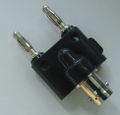Banana connector

The Banana connector is a 4 millimeter (0.16 in) pin with one or more lengthwise springs that bulge outwards slightly, giving the appearance of a banana. More modern plugs have a springy shroud surrounding the center pin.
The socket has a straight 4 mm bore. It can also be combined with a binding post.
The banana connector was invented in 1924 by Richard Hirschmann. The company Hirschmann is still in business, and among other products still manufactures plugs, sockets, test leads, clips etc. using this standard. Today's banana plugs often include insulating parts for safety against accidentally touching live connectors. If the plug has a retractable safety sheath, it is compatible with older plain 4 mm sockets, whereas non-retractable sheaths require safety sockets.
Where banana plugs are used in pairs (e.g., power and ground) such as in the BNC adapter shown below, it is customary to place the two connectors 3/4 inch (about 19 mm) apart.
A number of European mains power socket systems have been derived from this dual-banana arrangement, and as a consequence there is some cross-compatibility between power plugs/sockets and dual banana sockets/plugs, although such connections are normally not electrically safe.
Tektronix Banana Cables
- 012-0031-00 red 18" banana cable
- 012-0039-00 black 18" banana cable
- 012-0091-00 red 18" banana to BNC cable
- 012-0090-00 black 18" banana to BNC cable
Pictures
-
Banana plugs
-
Banana socket / binding post
-
Banana to BNC adapter
-
Safety banana jacks



